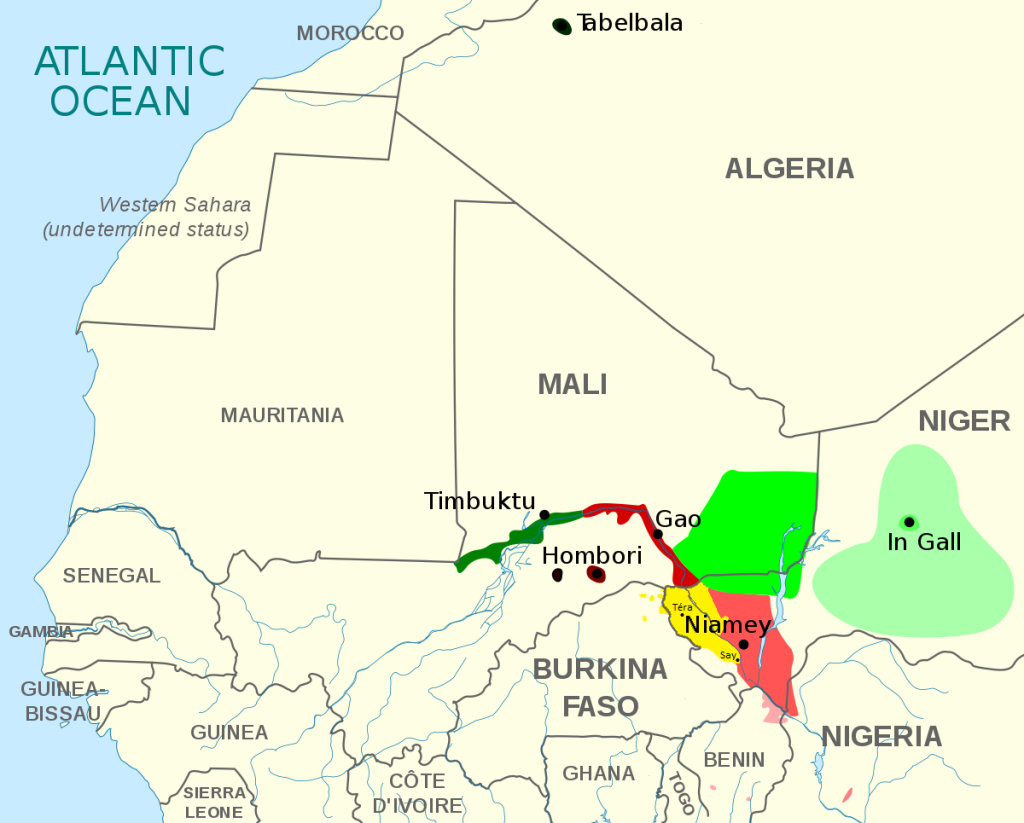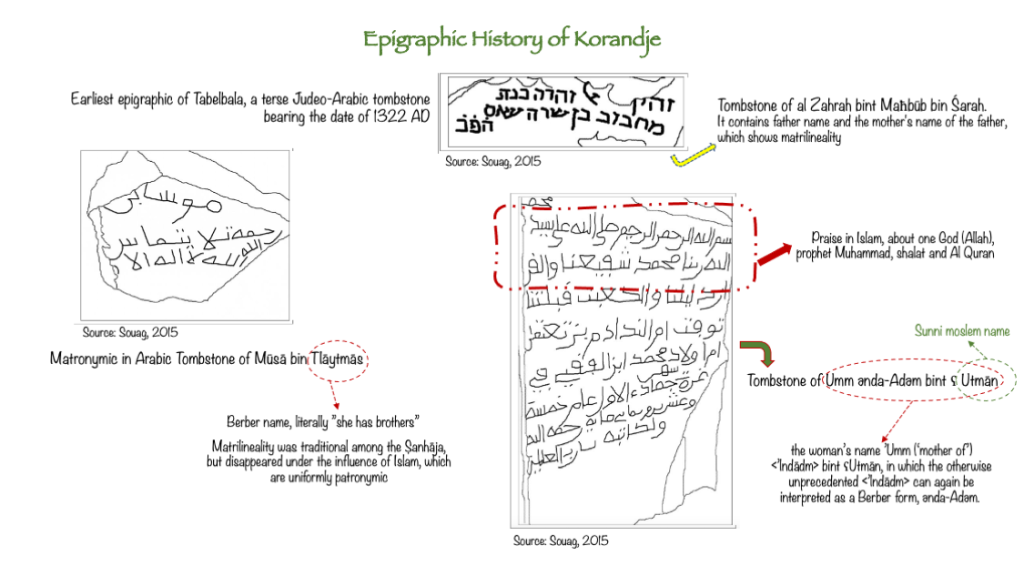Written by Muzzar Kresna and Leo Dietrich
Korandje (also Kwarandzyey) is a linguistic fascination, but a dying one. It is a northern Songhai language, or more precisely, by far the most northern of the northern Songhai languages. The other three northern Songhai languages still spoken today are spoken in Mali and Niger, but Korandje is spoken in Tabelbala, an oasis in southwestern Algeria, 1000 km from the nearest Songhai speakers. Tabelbala has 5000 inhabitants. Most of them speak Korandje – sometimes. And except them, no one does.

Forgotten metropolises
To understand how a Songhai language could come so far north, let us consider history for a moment. The once powerful Songhai empire had its heyday in the 15th and 16th centuries. Its capital was Gao (modern Mali) and the empire stretched across Niger, Mali, Mauritania, Senegal, Nigeria, Guinea, Gambia, Burkina-Faso, Ivory Coast and even a small part of southern Algeria. But Tabelbala was no part of it.
A theory expressed in earlier research by Dominique Champault, according to which former slaves stopped in Tabelbala on their way to Morocco and brought the language with them, is no longer shared today. It is more likely that it has to do with the trans-Saharan trade, which for centuries connected the Sahel with North Africa and in which many empires were involved. Lameen Souag argues that Tabelbala was on the route between Sijilmasa (Morocco) and Bilad as-Sudan and, as one of the few fertile places, was used early on for stopovers.
Excluding the marginal case of Arawan in the south on the Timbuktu route, Tabelbala is the only place where agriculture is feasible along the most direct routes between Sijilmasa and Taghaza, Timbuktu, and Walata. [Souag 2015]
A place that was known for trade eventually became agricultural. Souag sees this as a deliberate move by the elites of Walata and Timbuktu. But the Songhai Empire fell and the connection to the south was lost.

But you can dig a long time in the past without calling a spade a spade. So what kind of language is Korandje?
May it be a little bit of everything?
Korandje has undergone significant sound changes relative to proto-Songhai (Souag as cited in Sorosoro, 2011). The language is very heavily influenced by Berber and Arabic where the most basic vocabulary is of Songhai origin, but besides that, most of the vocabulary is not.
“The reflexes of ɣ, wC , *xC , along with various idiosyncratic changes, demonstrate that Korandje loans from at least two distinct Berber varieties: one (with reflexes Ø, bC , kC ) belonging to Western Berber, and one (with reflexes ɣ , wC , xC ) belonging to the rest of Berber (Souag, 2010).” “Apart from differences in sound reflexes based on source, Korandjé has undergone extensive sound changes such as əər/ar/ur > ạ, ir > ya, l > r, affrication of non-emphatic coronal stops ( t, d > ts, dz ), raising of mid vowels e, o > i, u ), loss of vowel length and ton e contrasts,and laxing of vowels in final closed syllables ( a / i / u > ə or rarely u > ǔ )” (Souag, 2015).

Korandje is brought to Tabelbala from the Sahel at a period when Tabelbala was already familiar to Berber speakers. In the economic activities, the people who brought Korandje to Tabelbala had a mixed economy combining farming and herding, that dwells around the oasis. This can be seen from the absorption in words in Korandje on several topics around animals and plants.
- acacia (Acacia tortilis raddiana): ạmạdi < Berber (Old Tashelhiyt amrad, Zenaga ämāräḏ)
- desert truffle (Terfezia arenaria, formerly leonis): tsạṛfṣ < Berber (Ouargli tarfəst, Tamahaq tarfəst; pl. tirfas > regional Arabic tərfas)
- fagonbush (Fagonia sp.): ṭṭliħiyya < Arabic aṭ ṭulayħah ‘little acacia’
- dab lizard (Uromastyx acanthinura, formerly acanthinurus): agərzəm< Berber (Taznatit agizam, Tamahaq agăzzăram, Gao agažirim).
- viper: gunzi < Songhai, cp. Gao
In religion, only the basic verbs gənga ‘to pray’ (cp. Gao jiŋgar), həymu ‘to fast’ (cp. Gao mee haw), tsyu ‘to read’ (cp. Gao čew), qʷəs ‘to slaughter, to sacrifice’ (cp. Timbuktu koosu), fəg ‘to bury’ (cp. Gao fiji) are retained from Songhai, along with guzu ‘ditch, grave’ (cp. Gao guusu).
- tsakʷẓẓən ‘afternoon prayer’, cp. Tashelhiyt takʷẓin, Zenaga takkuzən
- tsyunəs ‘sunset prayer’, cp. Tashelhiyt tiwutši, Zenaga tnutyšaʔn
- tsyaḍəs ‘night prayer’, cp. Tashelhiyt tiyiḍəs, Zenaga təNyyuḍaššən
The one non genetic universal that distinguishes all Northern Songhai groups from all other Songhai speaking groups is their close symbiosis with Berber speaking groups, visible in language and culture alike (Souag, 2015). All Northern Songhai languages are very heavily influenced by Berber, except at Tabelbala.
A place to live and to speak
In today’s modern world, it is hardly possible to live in seclusion. But the long seclusion has preserved the Korandje in Tabelbala. Meanwhile, there are many who leave the oasis due to economic reasons, as well as others who come and do not speak the language. Arabic is taught in schools, Korandje is not. It owes its existence to the passing on of the elders to the younger ones. And not everyone does that. Once this principle no longer works, it is only a matter of time before Korandje dies out.
The Korandje language revitalization program is minimal and very limited. One of few is done by Lamine Souag, a post-doctoral fellow from SOAS-University of London. On the other hand, the revitalization of the Korandje also experienced challenges and resistance from the people in Tabelbala itself. This is due to the perception that this language is not useful for use outside the oasis. This condition makes even in Tabelbala this language is rarely used because of there is no economic benefit for people to learn Korandje. And so the authors of this text are happy to raise a little more awareness of a language that is literally an oasis in the desert.
Korandje is entirely forgotten by the scientific world. Well not entirely! One small group of indomitable linguists still holds out against the oblivion….[Asterix and the Oasis of Tabelbala]
Recommended reading: Souag, Lameen: Explaining Korandjé
https://halshs.archives-ouvertes.fr/halshs-01376165/file/souag2015-explaining-korandje-postprint.pdf

